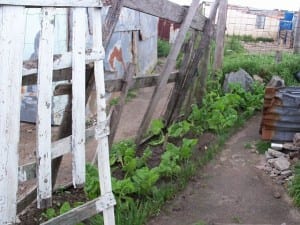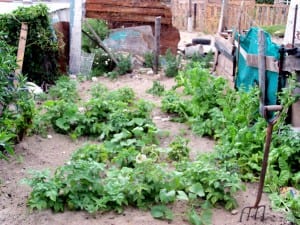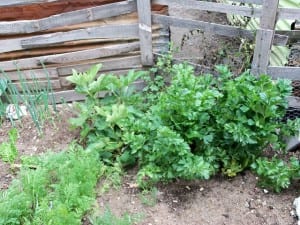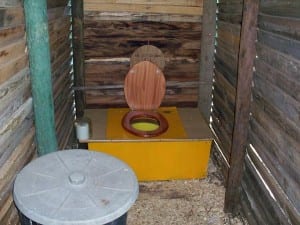Background
 Informal settlements, such as Monwabisi Park, South Africa, are built by groups of people looking for a temporary place to live while seeking employment in nearby economic centres. When the economy of these cities cannot sustain the population, the settlements become permanent because the residents cannot earn the means to relocate. Unemployment in these settlements can be upwards of fifty percent with many residents lacking necessities such as electricity, running water, or toilets (Strategic, 2001). Following this pattern, resources for the residents of Monwabisi Park are often minimal and not readily available. Foods, in particular fruits and vegetables, are expensive and may require residents to travel long distances to purchase them at markets. With the existing agricultural conditions, many families are already spending large portions of their income on food (Envisioning Endlovini, 2008). Fresh fruits and vegetables do not make up a large portion of residents’ diets and malnutrition is commonplace (Dannhauser, 2000). Although some residents have gardens, little food is self-produced. For most, there is not enough space available outside their dwellings to have a garden. Many residents lack sufficient time and money to dedicate to gardening because they struggle to provide food and shelter for their families. The lack of necessary resources and start up costs limit the prevalence of gardening in Monwabisi Park.
Informal settlements, such as Monwabisi Park, South Africa, are built by groups of people looking for a temporary place to live while seeking employment in nearby economic centres. When the economy of these cities cannot sustain the population, the settlements become permanent because the residents cannot earn the means to relocate. Unemployment in these settlements can be upwards of fifty percent with many residents lacking necessities such as electricity, running water, or toilets (Strategic, 2001). Following this pattern, resources for the residents of Monwabisi Park are often minimal and not readily available. Foods, in particular fruits and vegetables, are expensive and may require residents to travel long distances to purchase them at markets. With the existing agricultural conditions, many families are already spending large portions of their income on food (Envisioning Endlovini, 2008). Fresh fruits and vegetables do not make up a large portion of residents’ diets and malnutrition is commonplace (Dannhauser, 2000). Although some residents have gardens, little food is self-produced. For most, there is not enough space available outside their dwellings to have a garden. Many residents lack sufficient time and money to dedicate to gardening because they struggle to provide food and shelter for their families. The lack of necessary resources and start up costs limit the prevalence of gardening in Monwabisi Park.
Current Conditions
 In addition to nutritional and economic hardships, the people of Monwabisi Park also face the challenge of obtaining the proper supplies to deal with the physical conditions of their community. The soil in Monwabisi Park is arid, sandy, and due to the location of the park on an old landfill, satiated with garbage. The VPUU did a base line survey of Monwabisi Park and discovered that out of the 546 residents surveyed, less than 150 had a garden area and only four people in the survey population were actually growing a vegetable garden in their household. This general lack of gardening within the community can be accounted for by the difficulty and length of time it takes in the Monwabisi conditions to produce a worthwhile harvest (VPUU, 2009). We learned through our own experience that gardening in Monwabisi Park without proper composting techniques is inefficient and ineffective. Without modification, the landscape is extremely intolerant to growing most plants and vegetables. The heavy winds of the Cape Flats also pose problems; if not properly shielded, plants will be stunted in growth. In Monwabisi Park, gardening is not commonplace due to limited access to proper supplies, poor soil conditions, and a lack of motivation for the gardening process.
In addition to nutritional and economic hardships, the people of Monwabisi Park also face the challenge of obtaining the proper supplies to deal with the physical conditions of their community. The soil in Monwabisi Park is arid, sandy, and due to the location of the park on an old landfill, satiated with garbage. The VPUU did a base line survey of Monwabisi Park and discovered that out of the 546 residents surveyed, less than 150 had a garden area and only four people in the survey population were actually growing a vegetable garden in their household. This general lack of gardening within the community can be accounted for by the difficulty and length of time it takes in the Monwabisi conditions to produce a worthwhile harvest (VPUU, 2009). We learned through our own experience that gardening in Monwabisi Park without proper composting techniques is inefficient and ineffective. Without modification, the landscape is extremely intolerant to growing most plants and vegetables. The heavy winds of the Cape Flats also pose problems; if not properly shielded, plants will be stunted in growth. In Monwabisi Park, gardening is not commonplace due to limited access to proper supplies, poor soil conditions, and a lack of motivation for the gardening process.

Current Garden
Currently, agricultural activities in Monwabisi Park are minimal, consisting mainly of a small number of residents who have planted gardens around their homes. Some of these residents have completed a course on sustainability and gardening with the Soil for Life organization, and have a good understanding of gardening techniques and sustainability. However, based on field research which turned up only a handful of gardens in the community, it is apparent that interest has not spread beyond the small number of residents who have already established gardens. The benefits of increased gardening and sustainability awareness are great. There have been some solutions proposed and implemented by the Shaster Foundation and by local residents of Monwabisi Park. In the past few years, the Shaster Foundation has offered a biannual gardening competition, where the winner receives a cash prize (Womersley, 2008). The foundation has also planted a few organic gardens around the community buildings in Monwabisi Park; most specifically, the crèche building (Womersley, 2008).
Important Organizations

creche garden
An extensive program is needed in order to bring sustainability and agricultural activities to Monwabisi Park. One organization that provides such a program works in the Cape Flats is Abalimi Bezekhaya. This NGO’s goal is to counteract poverty in the informal settlements by establishing programs that bring together and train the community while providing residents continual support and access to resources. Subsidized supplies like seedlings, manure and compost are provided at different program garden centres located within the community. Economic outputs are also included through the hosting of organic markets where local gardeners can sell excess produce. Much of the work is done in collaboration with other organizations and groups to create extensive and sustainable support (Abalimi).
Soil for Life is another non-profit organization based in Cape Town that focuses on creating sustainable agriculture through education. They hold workshops that cover many aspects of sustainable gardening, such as composting, container gardening, and water wise gardening (Soil for Life, 2009). Soil for Life also has their own permaculture garden where they raise seedlings, maintain a vermiculture system, and experiment with different sustainable gardening techniques. One unique feature of Soil for Life’s garden is the dry-composting system they have established for their toilet facility. By setting up three bins and filling them one at a time, they are able to safely use the compost from the first bin in their gardens once the last bin is full. This is a unique system of pasteurizing human waste that has the potential for implementation in the Indlovu Centre’s Sanitation Facility.
Composting Waste for Use in Gardening

The Composting Toilet at Soil for Life
If treated and pasteurized correctly, human waste compost can be used as fertilizer for gardens around the community. The concept of pasteurizing waste is that, given a certain amount of time, heat will kill off all the pathogens in the waste. The simplest form of pasteurization is solar pasteurization. This system uses the energy of the sun to ‘hot box’ the compost (Lachapelle). At any temperature, with enough time allotted, the heat will remove harmful pathogens while leaving beneficial micro-bacteria intact (Sutcliffe). This method of treating waste has been successfully employed in Yosemite National Park and can be replicated with relative ease.
If the waste compost is to be treated nearby to the toilet facilities as well as homes, odor control becomes a major issue. One possible way of controlling odors is the use of effective microorganisms. Effective microorganisms are specific phototrophic bacteria that serve a variety of purposes by simply performing naturally in their microbial colonies. These types of microorganisms could be used to accelerate the decomposition of waste in the Indlovu Centre’s proposed Sanitation Facility. The bacteria feed upon the very organic compounds that cause odor (hydrogen sulfide, methane, etc), therefore eliminating most odors inherent in a dry composting system. This works especially well when the waste is taken from the system and put into an external composter, such as a solar pasteurizer. The elimination of odors also eliminates the problem of flies around the toilets. The phototropic bacteria also have detoxifying properties and can turn harmful bacteria into beneficial ones (Efficient Microbes SA). EM has the potential to significantly improve the quality and functionality of a dry compost toilet system.
[09Gardens]


